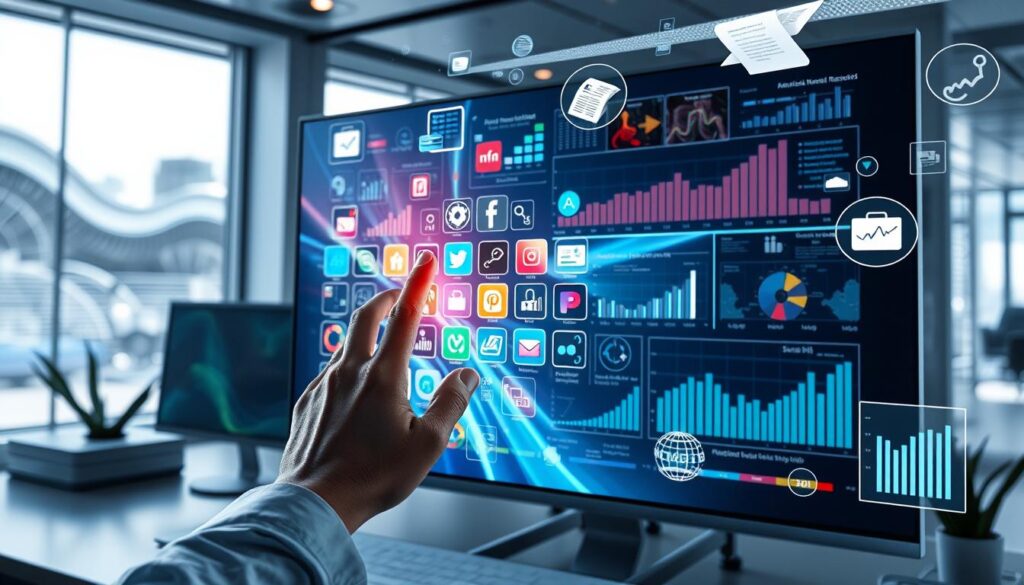In today’s fast-paced medical world, keeping up with the latest research is key. Healthcare professionals face a sea of information, from new studies to groundbreaking discoveries. Learning to speed read can change the game, helping us quickly grasp new knowledge and keep our practices current.
This guide will show you how to speed read effectively. It’s designed for medical professionals to stay on top of research and advancements. By using rapid reading techniques, we can quickly sift through medical literature, improve our productivity, and retain more knowledge. This way, we can keep up with healthcare’s fast pace.
Key Takeaways
- Discover how speed reading can help medical professionals navigate information overload and stay up-to-date with the latest research
- Learn effective rapid reading techniques to boost your efficiency in reviewing medical literature
- Explore strategies to enhance your comprehension and retention of healthcare-related knowledge
- Understand the importance of accelerated learning for continuous professional development in the medical field
- Gain insights into managing information overload and curating relevant medical data
Why Speed Reading Matters for Medical Professionals
Medical professionals face a huge challenge with all the research and journals out there. It’s hard to keep up, leading to feeling overwhelmed. Speed reading can help us manage this and stay current with the latest research.
Navigating Information Overload
The medical field changes fast, with new studies and guidelines popping up all the time. It’s easy to get lost in all the information. Speed reading helps us quickly get through a lot of data, keeping us informed without feeling overwhelmed.
Staying Current with Evidence-Based Practice
To give top-notch care, we need to know the latest evidence-based practices. But there’s so much medical literature out there. Speed reading lets us quickly find and understand new studies and guidelines, helping us make better decisions for our patients.
“Speed reading is a crucial skill for medical professionals to master in order to navigate the constant flow of information and ensure they are providing the best possible care.”
In today’s fast world of healthcare, keeping up with education and knowledge is key. Speed reading is a powerful tool for us to stay ahead and give our patients the best care.
Effective Rapid Reading Techniques for Medical Literature
Medical professionals face a huge amount of research every day. Learning to read quickly can change the game. It lets us quickly understand the vast medical information out there.
Eye-tracking exercises are a key strategy. They help our eyes move faster over the page. This way, we can read faster without losing understanding. Also, stopping the habit of silently saying words in our heads helps us read even quicker.
Skimming is another great technique for medical literature. By scanning headings, abstracts, and key points, we find the most important info. This method helps us sort through medical research more easily.
Using these rapid reading methods daily can greatly improve our work. It helps us learn faster and stay up-to-date with the latest medical practices. This way, we can give our patients the best care possible.
| Rapid Reading Technique | Benefits |
|---|---|
| Eye-Tracking Exercises | Improves reading speed without compromising comprehension |
| Subvocalization Reduction | Frees up cognitive resources and further boosts reading pace |
| Skimming Techniques | Helps navigate the sea of medical research and publications efficiently |
By using these rapid reading techniques, we can keep up with the fast-changing world of medical literature. This way, we can always give our patients the best care.
Enhancing Comprehension and Retention
Speed reading is more than just reading fast. It’s about understanding and remembering what you read. We’ll look at strategies to help you engage with what you read, understand it better, and keep that knowledge for a long time.
Active Reading Strategies
Effective speed reading means being active, not passive. Here are some strategies to improve your understanding and memory:
- Previewing the material by skimming headings, subheadings, and key points before diving into the details.
- Actively highlighting or annotating the text to mark important concepts, questions, and connections.
- Engaging in self-reflection by pausing to summarize, question, and relate the information to your own experiences and prior knowledge.
- Using visualization techniques, like creating mental models or diagrams, to better understand and remember the content.
- Practicing spaced repetition, reviewing the material at strategic intervals, to solidify your long-term retention.
By using these active reading strategies, you can dive deeper into your reading. This way, the knowledge you gain will stay with you for a long time.
“The key to effective speed reading is not just to read faster, but to read more actively and engage deeply with the material.”
Accelerated Learning Strategies for Healthcare Knowledge
Medical professionals face a flood of new information every day. This includes the latest research and new treatment methods. To keep up and give our best care, we must learn quickly and remember well.
Spaced repetition is a great way to do this. It breaks down info into bits and reviews them at the right times. This helps us remember things for a long time. Using spaced repetition, we can keep important health info ready to use.
Active recall is another smart strategy. Instead of just reading or listening, we test ourselves or teach others. This makes us understand and remember better. It also helps us use what we know in real life.
| Accelerated Learning Technique | Benefits |
|---|---|
| Spaced Repetition | Improved long-term knowledge retention |
| Active Recall | Enhanced comprehension and application of information |
| Interleaving | Ability to make connections and identify patterns across different topics |
| Multimedia Learning | Engaging multiple senses to improve information encoding and recall |
Using these accelerated learning strategies in continuing medical education makes learning faster. It helps us learn more and care for our patients better. The most important thing is to find what works best for each of us.

Speed Reading for Medical Pros: Keeping Up with Research
Medical professionals face a flood of new research and clinical trials every day. Keeping up with the latest is key to top-notch care. Speed reading can be a big help in staying current and boosting productivity.
Speed reading makes it easier to review medical literature. We can quickly find important information. This skill helps us understand and apply new research fast.
Here’s how some medical pros use speed reading to stay ahead:
- Dr. Emily Johnson, a cardiologist, now reviews cardiovascular research in half the time. This lets her use new treatments quickly.
- Nurse Practitioner Sarah Williams uses speed reading to keep up with nursing research. This helps her improve patient care.
- Dr. Michael Chen, an oncologist, quickly understands trial results. This guides his treatment choices and helps patients get the best care.
Speed reading helps us manage our research better. It keeps our knowledge current and helps us give better care. This skill saves time and improves our work.
| Speed Reading Benefit | Application in Medical Practice |
|---|---|
| Efficient information processing | Quickly reviewing the latest research and clinical trials |
| Improved comprehension and retention | Deeper understanding of emerging medical evidence |
| Increased research productivity | Incorporating new findings into patient care strategies |
Speed reading lets us stay ahead in medical research. We can use the latest findings in our daily work. This skill boosts our professional growth and helps us give the best care to our patients.
Research Productivity and Time Management
Medical professionals face a huge challenge with all the research and scientific literature out there. It’s hard to keep up, but speed reading can help a lot. It makes it easier to stay current with new medical discoveries.
Prioritizing Relevant Information
Sorting through all the medical literature to find what’s most important is tough. Speed reading helps us quickly scan abstracts and summaries. This way, we can focus on the studies that really matter.
To be more productive, we can organize our research better. We can sort it by specialty or how relevant it is. This helps us tackle the most critical issues first and stay on top of our field.
| Technique | Benefits |
|---|---|
| Rapid Scanning | Quickly skim through abstracts, summaries, and key sections to identify the most relevant information |
| Targeted Prioritization | Organize medical literature by specialty, relevance, and potential impact to maximize productivity |
| Curated Databases | Leverage specialized databases and resources to streamline access to the most up-to-date and authoritative medical research |
By using speed reading and smart ways to sort information, we can do more research in less time. This is key for busy medical professionals.
Continuing Medical Education and Lifelong Learning
As healthcare professionals, we must always learn more. Lifelong learning keeps us ahead in our field. By using continuing medical education (CME) and speed reading, we can quickly grow our knowledge. This helps us give our patients the best care.
The world of medicine is always changing. Healthcare knowledge retention is key. Speed reading helps us quickly read through lots of research and literature. This keeps us current with new discoveries and best practices.
CME programs offer many ways to grow professionally. From online courses to virtual conferences, we can learn a lot. Speed reading makes these resources even more valuable. It helps us remember important details and make better decisions.
Learning for life benefits our patients and us. As we get better at speed reading, we open up new possibilities. Our medical skills and love for learning can make a big difference in healthcare.
“Continuous learning is the minimum requirement for success in any field.” – Brian Tracy
Overcoming Information Overload in Healthcare
In the fast-changing world of medicine, healthcare workers face a huge amount of information. This includes the newest medical studies and treatment methods. The amount of data can be overwhelming, leading to “information overload.” This can harm patient care, as important details might be missed.
Filtering and Curating Medical Data
To fight information overload, healthcare providers need good ways to filter and curate medical data. By using a clear method to manage information, they can easily find and understand the latest medical news.
- Make a custom info filtering system: Use digital tools to pick the most important and trustworthy medical sources. Tailor them to your specific needs.
- Choose evidence-based resources: Stick to well-known journals, clinical guidelines, and studies. This ensures the info you get is based on solid science.
- Use a structured curation process: Create a way to organize, keep track of, and find the info you collect. This helps you quickly use important insights.
- Work with colleagues: Join knowledge-sharing groups and forums. This way, you can use everyone’s knowledge to stay updated.
By getting good at filtering and curating medical data, healthcare workers can beat information overload. They can keep their knowledge sharp and current in the fast-changing world of healthcare.

“Effective information management is the key to delivering high-quality, personalized healthcare in today’s data-driven world.”
Conclusion
Speed reading and learning fast are key for doctors to keep up with new medical research. These skills help us give our best care to patients. By using the tips from this guide, we can work smarter, remember more, and lead in our fields.
Learning to read quickly helps us deal with a lot of medical info. We can spot important points fast and grow our knowledge. This lets us make better choices, offer treatments based on solid evidence, and give top-notch care.
By adopting these new ways, doctors can stay ahead, bring new ideas, and change healthcare for the better. Speed reading and learning fast open doors to better work, more education, and keeping up with health news. This leads to a healthier, more informed world for everyone.




